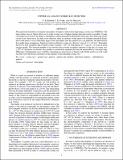Jupiter as a giant cosmic ray detector
Abstract
We explore the feasibility of using the atmosphere of Jupiter to detect ultra-high-energy cosmic rays (UHECRs). The large surface area of Jupiter allows us to probe cosmic rays of higher energies than previously accessible. Cosmic ray extensive air showers in Jupiter's atmosphere could in principle be detected by the Large Area Telescope (LAT) on the Fermi observatory. In order to be observed, these air showers would need to be oriented toward the Earth, and would need to occur sufficiently high in the atmosphere that the gamma rays can penetrate. We demonstrate that, under these assumptions, Jupiter provides an effective cosmic ray "detector" area of 3.3 × 107 km2. We predict that Fermi-LAT should be able to detect events of energy >1021 eV with fluence 10-7 erg cm-2 at a rate of about one per month. The observed number of air showers may provide an indirect measure of the flux of cosmic rays ≳ 1020 eV. Extensive air showers also produce a synchrotron signature that may be measurable by Atacama Large Millimeter/submillimeter Array (ALMA). Simultaneous observations of Jupiter with ALMA and Fermi-LAT could be used to provide broad constraints on the energies of the initiating cosmic rays.
Citation
Rimmer , P B , Stark , C R & Helling , C 2014 , ' Jupiter as a giant cosmic ray detector ' , Astrophysical Journal Letters , vol. 787 , no. 2 , L25 . https://doi.org/10.1088/2041-8205/787/2/L25
Publication
Astrophysical Journal Letters
Status
Peer reviewed
ISSN
2041-8205Type
Journal article
Description
All authors highlight financial support of the European Community under the FP7 by an ERC starting grant.Collections
Items in the St Andrews Research Repository are protected by copyright, with all rights reserved, unless otherwise indicated.

